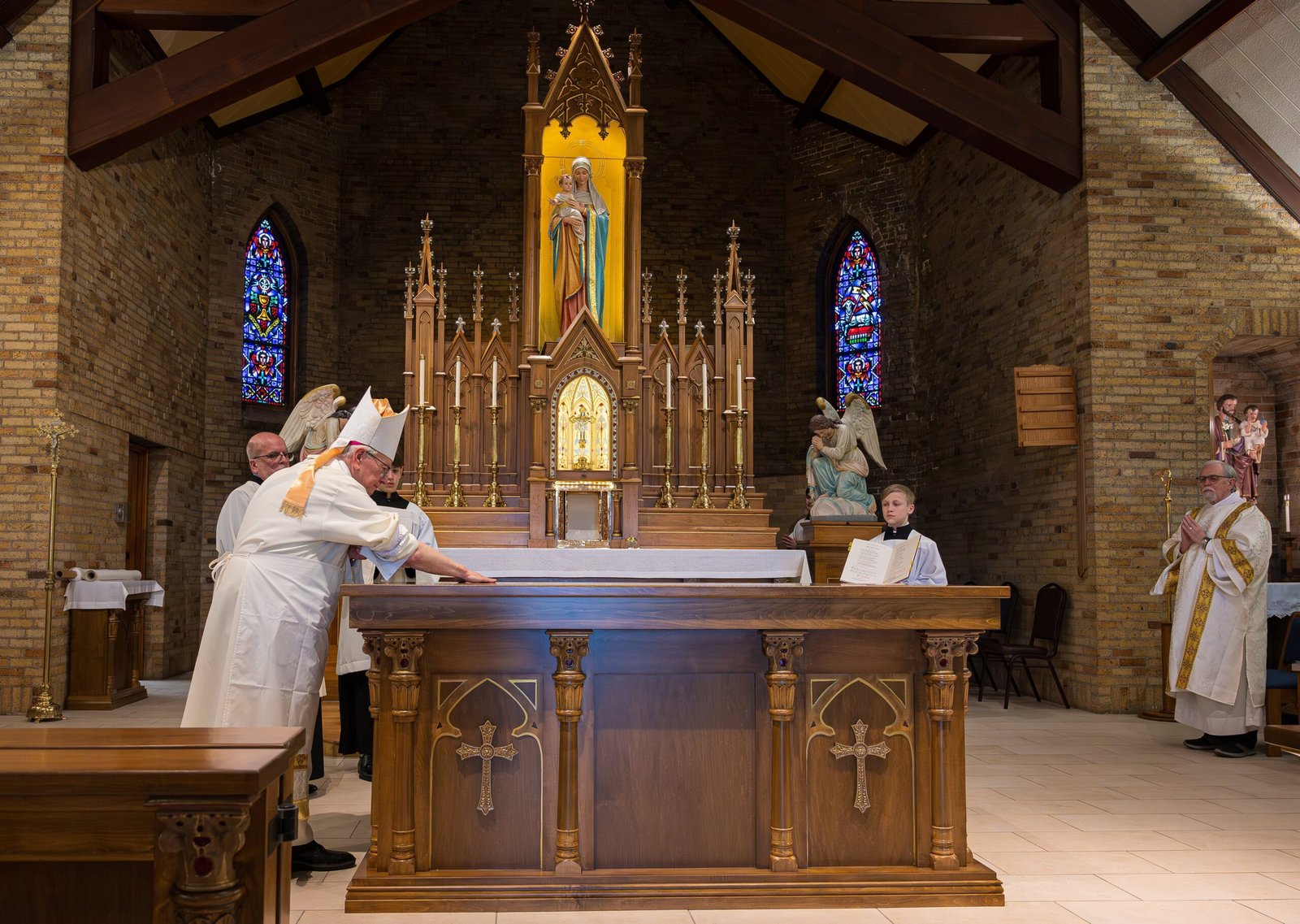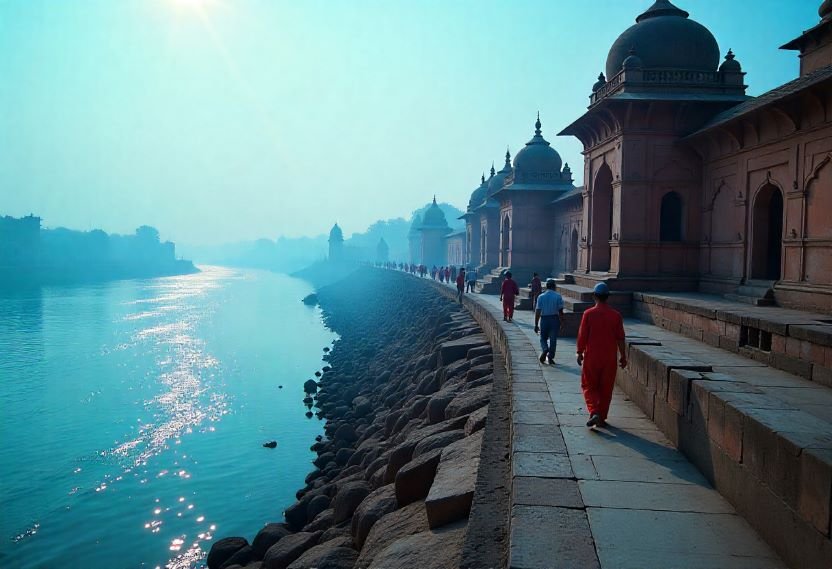Spiritual Travel
3 Wisconsin Marian shrines launch Jubilee Pilgrim Passports

(OSV News) — When you travel overseas, you take your passport along. It identifies who you are, while its many and varied stamps serve as a history of where you’ve been. Passports also lead us to look forward to where we are going.
That is also the idea behind a Pilgrim Passport for the Jubilee Year of 2025, developed by three Marian shrines in Wisconsin. Each is a designated pilgrimage site for the Jubilee Year:
— The Basilica and National Shrine of Mary Help of Christians in Hubertus, near Milwaukee. It is locally known as “Holy Hill.”
— The National Shrine of Our Lady of Champion, near Green Bay.
— The Shrine of Our Lady of Guadalupe in La Crosse.
“Pilgrimage is, of course, a fundamental element of every Jubilee event,” the late Pope Francis wrote in announcing the Jubilee. “Setting out on a journey is traditionally associated with our human quest for meaning in life.”
Reflecting on this meaning brought the Pilgrim Passport idea to the staff at Champion.
‘Beautiful Response’ to Passports
“It was in response to ‘How can we make this a fun year for pilgrims who are traveling this Jubilee Year?’” explained Chelsey Hare, communications director at Champion. “Not everyone can make it to Rome. And so (we thought), there are these beautiful shrines in Wisconsin dedicated to Our Lady. And we’ve had such a beautiful response already (to the passports).”
Hare, who designed the passports, said that they reflect Pope Francis’ naming Mary as “Our Mother of Hope” in his 2024 bull of indiction announcing the Jubilee Year, “Spes non confundit” (“Hope does not disappoint”).
“The Jubilee Year is a profound invitation for Catholics to deepen their faith through pilgrimage,” said Discalced Carmelite Father Mark-Joseph DeVelis, rector at Hubertus. “By uniting our shrines through the Pilgrim Passport, we are offering a tangible way for the faithful to mark their journey and embrace the grace of this Holy Year.”
Stamps Bear Shrines’ Logos
Each shrine has free passports and pilgrims may get theirs stamped at each shrine’s gift shop. Each stamp bears the unique logo of its shrine for pilgrims to collect as they travel. The passports also include information and highlights about each shrine, as well as devotions and explanations about the Holy Year’s plenary indulgence. While the passports are currently in English, a Spanish version will be available soon.
The hope, Hare said, is to get the passports to people as they travel during the prime pilgrimage season — mid-April through October. Pope Francis, in his letter, had called upon Catholics to become “pilgrims of hope.”
In that vein, Father Anthony Stephens, a Father of Mery, who is rector of the shrine at Champion, noted that, “We are delighted to partner in this meaningful endeavor to bring more pilgrims to Jesus through Our Lady.”
Pilgrims Always Travel in Hope
Pilgrims always travel in hope. This is as true today as it was for the Catholics who settled the area that became Wisconsin. The earliest came from Canada, arriving as 17th-century fur traders. They and their families spread the Catholic faith to the Indigenous people around Green Bay and the Fox River. Next came Europeans, such as the Irish and Germans who came in the 1840s to the 1890s.
The first diocese in Wisconsin was established in Milwaukee in 1843 under Bishop (later Archbishop) John Henni, himself an immigrant from Switzerland. Even today, Milwaukee has the largest population of German Americans in the United States.
Wisconsin also attracted Catholics from Poland and other East European countries, as well as Belgian and Dutch Catholics. In later days, the state became home for Hispanic and Southeast Asian immigrants.
Strong Faith Led to Founding of Shrines
The faith of all led to the founding of churches and shrines, including the three Pilgrim Passport shrines:
— Holy Hill: The National Shrine of Mary Help of Christians traces its roots to the Irish immigrant farmers who first called it “Holy Hill” or “St. Mary’s Hill” in the mid-1800s. In the early 1860s, Francois Soubrio arrived from his native Quebec to live as the “Hermit of Holy Hill.” The first shrine church was dedicated in 1863. The present one was consecrated in 1931. Carmelites serve the shrine.
— Our Lady of Champion: The National Shrine of Our Lady of Champion arose after a Belgian immigrant — Adele Brise — experienced three visions of the Queen of Heaven in October of 1859. The first chapel was built by her father, Lambert. The present chapel was built in 1940. In December 2010, Adele’s visions were designated as “worthy of belief,” and the site was named a national shrine in 2016. Fathers of Mercy serve the shrine.
— Our Lady of Guadalupe in La Crosse: This shrine was begun by Cardinal Raymond L. Burke while bishop of La Crosse. Construction of the church began on May 13, 2004, with its dedication on July 31, 2008. The shrine, set on 100 acres, includes the Memorial to the Unborn. The Italianate-style church has a 100-foot dome.
As pilgrims travel to each of these shrines, their use of the Pilgrim Passports will be an aid in reflection during this Year of Hope.
“The Pilgrim Passport is more than a keepsake,” said Father Edward Nemeth, a St. Louis archdiocesan priest, who is executive director of the La Crosse shrine. “It is an invitation to prayer, reflection and spiritual renewal through the lens of Mary as our Mother of Hope. We pray that all who embark on this pilgrimage can draw inspiration from her unwavering hope and maternal guidance, knowing it will always lead us closer to the heart of her son, Jesus.”
Patricia Kasten writes for OSV News from Wisconsin.
Source link
Spiritual Travel
Saudi Arabia sets record with 140k flights during Hajj 2025

Saudi Arabia set new records for air traffic during the Hajj 1446 AH (2025), managing over 140,000 domestic and international flights. This figure marked an 8% increase compared to the previous year, showcasing the Kingdom’s growing capability in handling large-scale religious travel. The successful movement of millions of pilgrims by air highlights Saudi Arabia’s strong logistics network, use of advanced technologies, and efficient coordination between airports and air navigation teams. This achievement reinforces the country’s role as a key player in global religious tourism.
The arrival and departure phases were handled with excellent precision. During the arrival phase, from Dhu Al-Qidah 1 to Dhu Al-Hijjah 8, a total of 74,902 flights were recorded—a 15% rise from last year. The departure phase, from Dhu Al-Hijjah 23 to Muharram 15, saw 66,072 flights, a 2% increase. On Dhu Al-Hijjah 2, the Kingdom recorded its highest single-day aircraft movements with 2,338 flights. These milestones reflect strong planning and readiness for peak travel seasons.
A total of 213 airlines participated in the Hajj 2025 season, significantly enhancing global connectivity. This shows Saudi Arabia’s importance as a central hub for Muslim pilgrims worldwide. Pilgrims from various continents accessed the Kingdom smoothly, benefiting from improved air services and facilities. The increase in airline participation highlights Saudi Arabia’s rising global reputation in aviation, particularly in supporting international religious travel through expanded air corridors and partnerships.
The Saudi Air Navigation Services (SANS) organisation played a critical role in this success. They deployed advanced air traffic management technologies and highly skilled professionals to ensure safe and smooth air operations. Engineers, controllers, and maintenance staff worked continuously to manage the high traffic volumes without delays. The effective use of technical infrastructure helped maintain safety standards, improve efficiency, and enhance the overall travel experience for millions of pilgrims at major airports.
Saudi Arabia’s success during Hajj 2025 shows that it is ready for future growth in religious tourism. Through strategic planning, modern technologies, and a focus on global partnerships, the Kingdom is setting new benchmarks for managing large-scale international travel. Its efforts not only support smooth pilgrim journeys but also strengthen its image as a global aviation and spiritual hub. This performance underlines the country’s commitment to safe, well-organised, and spiritually enriching experiences for all visitors.
Spiritual Travel
6 Indian cities where Lord Krishna’s divine presence still lives on

1.Mathura
Mathura, revered as the birthplace of Lord Krishna, holds immense spiritual significance in Hinduism. The Krishna Janmabhoomi Temple stands at the exact spot where he is believed to have been born in a prison cell. The atmosphere of the city is steeped in devotion, especially during Janmashtami, when thousands of devotees gather to relive the divine birth through rituals, music, and processions. Every corner of this ancient city echoes tales from Krishna’s early life.
Spiritual Travel
Uttar Pradesh Revitalizes Religious Tourism with Nine Crore Rupees Investment in Lucknow’s Temples and Riverfronts

Wednesday, August 6, 2025
As part of broader efforts to develop the tourism potential of the state, the Uttar Pradesh Tourism Department has sanctioned ₹9 crore funding to restore important religious and cultural sites in Lucknow. Famous temples and the riverfront areas on the Gomti River, considered the heart of the city, will be enhanced as part of this project which received approval in August 2025. This is likely to enhance religious tourism in Lucknow and enrich the experience for domestic and overseas tourists visiting some of the city’s cherished spiritual sites.
Key Projects Under the ₹9 Crore Plan
The development scheme comprises ten projects which enhances the religious and cultural tourism archetypes in Lucknow. The government of Uttar Pradesh has set aside some funds for the restoration and repairs of some important temples and also for the development of the riverfronts to facilitate more pilgrims and tourists. Some of the important projects are:
- Sheetla Mata Temple, Kakori: ₹1 crore has been set aside for restoration work on the Goddess Sheetla temple which is an important temple for the local devotees.
- Koneshwar Mahadev Temple, Chowk: Another ₹1 crore has been allocated for the servicing of the ancient Shiva temple which is visited by a large number of people paying their respects to Lord Shiva.
- Shiv Temple, Karheta (Ambedkar Nagar Ward):₹1 crore has been assigned for the restauration of the historic temple which is a known for being a spiritually appealing tourist site.
- Kalika Devi Temple, Amlauli Village: The Kalika Devi temple which is popularly worshipped by many people will be provided with ₹1 crore to be used towards the renovation and modernization works to better serve the devotees.
- Shri Hanuman Temple, Athnaru (Sukhmadatt Nagar): The Shri Hanuman Temple, which is a major worship place for many people will also have ₹1 crore allocated for its restoration.
- Shri Mahadev Jalsai Nath Temple: This temple will receive ₹1 crore earmarked for the enhancement of its development which will add to the spiritual services provided in the city.
- Shri Jwala Mata Temple, Barigwan: ₹50 lakh is to be provided for the enhancement works to the important temple of Goddess Jwala Mata which will improve the religious tourism in the area.
- Sanjhiya Ghat, Gomti River: ₹1 crore will be spent on the development of Sanjhiya Ghat on the Gomti River, an area visited by people for spiritual and ceremonial activities and offering some of the services.
- Shri Ram Janki Temple: The Shri Ram Janki Temple is receiving ₹1 crore for further development on the infrastructure. The shrine is uniquely positioned in such a way that shrines of both Rama and Janki can be visited.
- Ghatghata Baba Devsthan, Salehnagar Village: ₹50 lakh has been allocated for this temple, which holds deep significance for locals.
Alongside safeguarding the spiritual legacy, these initiatives seek to improve the overall experience for visitors. Aside from reconstruction of the ancient temples, the state government also aims to implement a sustainable model that boosts tourism while honoring the site’s cultural and religious values.
Improvement Plans for Visitor Facilities
As part of these temple restorations, the Government of Uttar Pradesh allocated significantly within the ₹9 crore budget towards developing the infrstruture of these religious sites. The upgrades will help in making the sites easier and more pleasant to access for travelers. The major upgrades include:
- Lighting Installations: To illuminate the temples and surrounding areas, improving the visual appeal and providing greater accessibility during evening hours.
- Sanitation and Hygiene Facilities: Ensuring that visitors have access to clean and well-maintained restroom facilities, which is crucial for sustaining the increasing foot traffic in these religious sites.
- Drinking Water Stations: To ensure the comfort and convenience of visitors, water stations will be installed at key locations to meet the needs of the increasing number of tourists.
- Pathway Development: New pathways will be constructed around the temples and riverfronts, making it easier for visitors to access the sites.
- Tourist Information Centers: These centers will be set up to offer guidance and information about the historical and spiritual significance of the temples, enhancing the overall visitor experience.
Promoting Religious Tourism as a Key Economic Driver
The ₹9 crores tourism development plan for UP is intended for religious tourism which is important for the state’s economic development. UP’s infrastructure for tourism is expected to improve which will enhance economic development for the state. Improvement of infrastructure will allow better access to important spiritual site to enhance the number of visitors and help with economic development. Improvement of sites will also assist in providing employment and preserving cultural and local businesses.
Additionally, the plan aligns with Uttar Pradesh’s ongoing commitment to preserving its rich religious and cultural heritage. The state has long been a hub for spiritual tourism, and with the proposed upgrades, it is positioning itself to become an even more attractive destination for pilgrims and tourists alike.
Conclusion: A Bright Future for Religious Tourism in Lucknow
Uttar Pradesh’s spending on restoring and building religious tourism sites signifies an important move towards augmenting the cultural heritage of the region while improving the experience for tourists. The investment will make certain that the sacred sites continue to evoke and attract pilgrims for years to come. The initial development of Lucknow’s spiritual landmarks will further aid the growth of tourism and create sustainable and enriching experiences for visitors from different parts of the globe. The state is also investing ₹9 crores for the initial development of Lucknow’s spiritual landmarks.
The restoration of Lucknow’s temples and riverfronts are set to boost the city’s tourism greatly. They will not only capture the attention of tourists whose interests lie in spirituality but will also attract culture enthusiasts. This is one of the few times when tourists can easily access the core of the ancient spiritual heritage in the state of Uttar Pradesh.
-

 Brand Stories2 weeks ago
Brand Stories2 weeks agoBloom Hotels: A Modern Vision of Hospitality Redefining Travel
-

 Brand Stories2 weeks ago
Brand Stories2 weeks agoCheQin.ai sets a new standard for hotel booking with its AI capabilities: empowering travellers to bargain, choose the best, and book with clarity.
-

 Destinations & Things To Do2 weeks ago
Destinations & Things To Do2 weeks agoUntouched Destinations: Stunning Hidden Gems You Must Visit
-

 Destinations & Things To Do2 weeks ago
Destinations & Things To Do2 weeks agoThis Hidden Beach in India Glows at Night-But Only in One Secret Season
-

 AI in Travel2 weeks ago
AI in Travel2 weeks agoAI Travel Revolution: Must-Have Guide to the Best Experience
-

 Brand Stories1 month ago
Brand Stories1 month agoVoice AI Startup ElevenLabs Plans to Add Hubs Around the World
-

 Brand Stories4 weeks ago
Brand Stories4 weeks agoHow Elon Musk’s rogue Grok chatbot became a cautionary AI tale
-

 Brand Stories2 weeks ago
Brand Stories2 weeks agoContactless Hospitality: Why Remote Management Technology Is Key to Seamless Guest Experiences
-

 Asia Travel Pulse1 month ago
Asia Travel Pulse1 month agoLooking For Adventure In Asia? Here Are 7 Epic Destinations You Need To Experience At Least Once – Zee News
-

 AI in Travel1 month ago
AI in Travel1 month ago‘Will AI take my job?’ A trip to a Beijing fortune-telling bar to see what lies ahead | China
